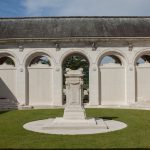 CLARK Robert, Private, died 22/10/1914 aged 32. Enlisted Bishops Stortford service no. 7485 Bedfordshire Regiment 1st Battalion. 22nd October 1914. He is remembered at Le Touret Memorial. Son of Mrs. Ellen Clark of Woodgates End Broxted Dunmow Essex and brother of Henry Clark.
CLARK Robert, Private, died 22/10/1914 aged 32. Enlisted Bishops Stortford service no. 7485 Bedfordshire Regiment 1st Battalion. 22nd October 1914. He is remembered at Le Touret Memorial. Son of Mrs. Ellen Clark of Woodgates End Broxted Dunmow Essex and brother of Henry Clark.
The Battalion diaries:
22 Oct 1914 An extract from the 1st Battalion history reads:
At 4 a.m. on the 22nd, the company moved out quietly, to dig a defensive supporting position north of the village, south of a hamlet called Rue du Marais. Lieutenants Litchfield and Coventry took a platoon each and worked on separate sections of the trench, the other two platoons being held around the barn on the fringe of the group of houses. In a thick mist and with visibility at a mere twenty metres, some 600 Cheshires and Bedfordshires were digging trenches in readiness for the anticipated assault. Unexpectedly, at 6 a.m. a huge group of German infantry burst from the fog and charged the digging men, having swept through the village with hardly a shot being fired. They attacked from two sides and their impetus and sheer force of numbers carried the position. The British had no time to drop their spades and pick up rifles so fought with their shovels, pick axes and fists in a brutal hand to hand brawl. Some 200 of the 600 men became casualties and the line was thrown back towards Rue du Marais, where it held.
Initially, the line around Rue du Marais was a jumbled collection of Cheshires and Bedfordshires, Royal Engineers and artillerymen, with elements from a few other unexpected units thrown in for good measure. Establishing a firmer line of resistance was their first priority, with folding the stragglers that appeared into their line coming a close second. Around forty of the company could be found, although more turned up as the day went on. However, Lieutenant William St. John Coventry, who would be mentioned in despatches in January 1915, and Second Lieutenant John Litchfield had both been killed leading their platoons during the vicious brawl and almost fifty more were killed or reported missing.
Around 8.30 a.m. the rest of the Bedfordshires were ordered to move to the east of Violaines, but made slow headway as the German artillerymen were saturating the reserve areas to stop any supporting troops moving up.
Several attempts to retake the village were made by the remnants of the Violaines garrison, reinforced with units from the 13th and 14th Brigades. At every attempt, they met with heavy rifle fire and the idea was soon given up, the last attack being forced to lie flat in front of the village for hours until they could creep back to their own lines. Amongst the final attack was Colour Sergeant Major Charles Hall and what remained of his platoon who were forced to dig in hurriedly under heavy fire. During the exchange, C.S.M. Hall was hit in the arm by a bullet which physically spun him round and rendered him incapable of wielding his rifle as well as giving him a ticket to a Newcastle hospital for a break from the fighting.
Thanks to Glyn Warwick for providing details from the battalion war diaries. He is written a book about the fallen heroes of Stansted Mountfitchet, “They Sleep In Heroes Graves” ISBN 978-0-9558964-0-8 and Bedfordshire Regiment Website.
The data is the editor’s interpretation of documents from the:
The National Archives London, Commonwealth War Graves Commission, Ancestry and Find My Past.

